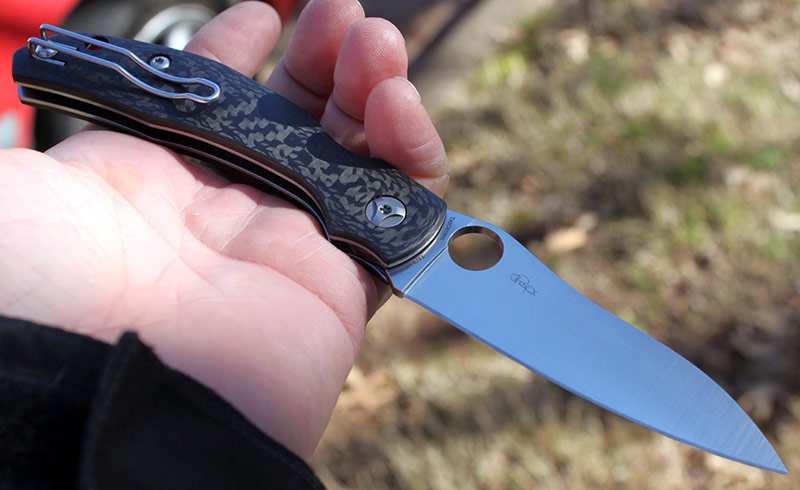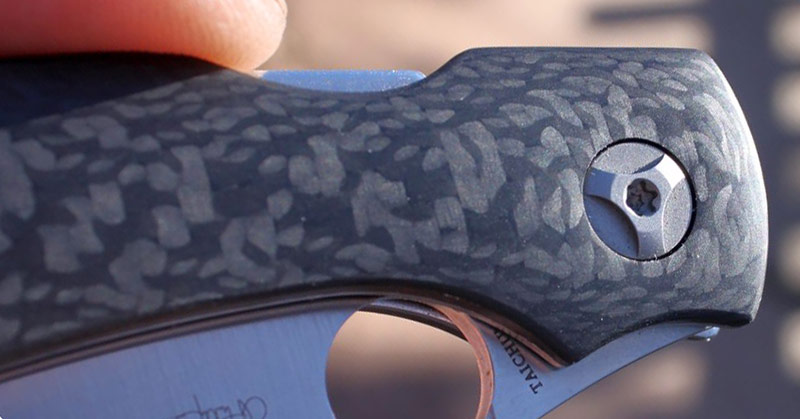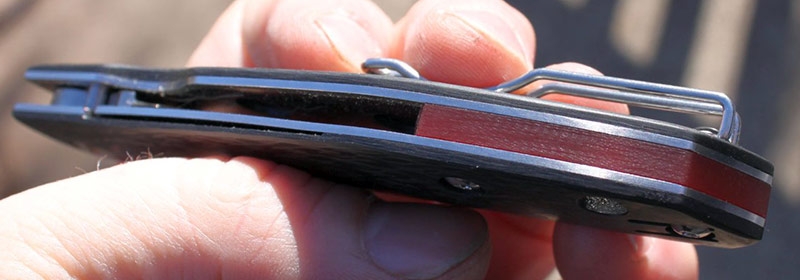We independently evaluate all recommended products and services. Any products or services put forward appear in no particular order. If you click on links we provide, we may receive compensation.
Spyderco these days seems to make only two kinds of knives: affordable knives that are long on utility and ergonomics and maybe short on what you’d call “visual appeal,” and artsy maker collaborations that combine wild design with high end materials and construction. These maker collaborations give custom knifemakers a much bigger platform to share their work with a larger audience, and this series of knives has produced some real legendary knives.

Today we’re looking at the Kapara, a collaboration between Spyderco and Alistair Phillips, an Australian custom knife maker. The Kapara is a production interpretation of Phillips’ Redback custom folder, but it’s one of the closest adaptations from custom to production out there, having nearly all of the flair and attention to detail that the full custom knife enjoys. The Redback was designed as a folding knife that excelled at food prep, placing the edge of the blade well below the underside of the handle. That means it has some natural competition in Spyderco’s lineup (which we’ll get to later), but it also gives the knife a unique appearance when open.
Knives that are good at food prep have some properties that make them excellent at other everyday tasks, and the Kapara has become a favorite of the EDC and Spyderco collector community since it debuted in 2018 – especially after the revised “CQI” version came out. Let’s take a look at this custom collaboration and see if it’s a docile sweetheart, or if its sting will leave you sweating, swollen, and the soles of your feet burning.
Key Specs: Spyderco Kapara
The Blade
The Kapara’s blade measures 3.58” (91mm) long, with a 3.42” (87mm) long cutting edge. The spine of the blade is relatively thin for its length at only 0.118” (3.0mm) thick, and this knife has a true full flat grind from the edge bevel all the way up to the spine. The sharpened edge is pretty much all belly, with a long continuous curve from the ricasso to the tip of the blade, which makes the knife work better for food prep as it enables rolling cuts. The spine features a unique “double hump” design as it bends toward the tip, the one closest to the pivot rising to make room for the thumb hole opener, and the one closer to the tip making a finger perch for detail work – as we’ll discuss in the field test section. The blade is only 1” high at its widest point, and the whole knife is relatively slim. The plunge line is unique on the Kapara, a gentle curve that bisects the rear end of the thumb hole. There is no sharpening choil, and the Kapara has a mild beard where the sharpened edge intersects the ricasso.

Blade steel on the Kapara, like many of Spyderco’s interesting design knives, is Crucible Industries CPM-S30V. These days you’ll hear a fair amount of complaining and general dissatisfaction about an expensive knife coming with an S30V blade – the Kapara retails for $203 at the time of writing. This is even truer now that CPM S30V has been superseded twice, first by S35VN in 2009, and now by S45VN in 2019.
It is worth remembering that just because CPM S30V came out in 2001 doesn’t mean it doesn’t work in 2020. It is still highly corrosion resistant, holds an edge very well, is quite tough, and is a well-rounded EDC steel. People tend to get caught in up in new names and marketing but the actual differences between S30V, S35VN, and S45VN are relatively minor in terms of composition and performance. CPM S30V is high carbon (1.45%, more than S35VN at 1.38 but less than S45VN at 1.48%) and above the 12% chromium threshold (at 14%) to be fully stainless. It also has molybdenum (for strength and hardness) and a high quantity of vanadium, which increases strength and wear resistance and limits grain size for a finer, more uniform edge. It is still out of date compared to S35VN and S45VN, but the difference on the consumer end is mostly related to how easy the steel is to sharpen – and that S35VN is slightly less prone to chipping. I haven’t handled anything with S45VN yet as it’s just starting to roll out, so I can’t offer any comparison there, but chemically they’re all fairly similar.
Deployment and Lockup
The Kapara I have is the “CQI” version which was introduced not long after the original, and added a pivot bushing to the design. A pivot bushing is a collar that fits around the pivot barrel, giving the blade a lower friction surface to rotate on and making the action of the knife smoother, particularly when closing – as opening is normally done with some force, whereas closing is done with gravity. The pivot bushing enables the Kapara to “drop shut” when you hold the lock open, which was a common gripe against the original Kapara.

A point of clarification: the pivot bushing on the CQI Kapara is a separate piece from the pivot barrel, rotating freely, unlike the pivot on the popular Paramilitary 2, which is a bushing and a barrel all as one piece – which acts more to set the tightened depth of the pivot and prevent overtightening. The Kapara uses a pair of phosphor-bronze washers on both sides of the pivot to reduce friction against the liners, which are by nature self-lubricating and long wearing. This in effect makes the knife open and close similar to a knife that uses a ball-bearing pivot, but it does not have the mechanical complexity of bearings or the susceptibility to dirt ingress messing up the action – which is important in a knife designed to cut up food!
The action itself is good – It’s very slick, being able to easily free-drop shut under its own weight when you hold the lock open. Opening is via a thumb hole in the blade which can be done with the thumb, or with the middle finger from the rear side of the blade in a flicking motion if you’re a cool guy on the internet (which I am, I am told.) One downside of the low-friction pivot is that the blade frequently bounces out of the closed position detent when you swing it shut, requiring a second hand motion to close it fully. Or maybe I just fidget with my knives too much?

The lock is Spyderco’s impressive compression lock, which is most well-known from the aforementioned Paramilitary 2 but has slowly begun to spread across the Spyderco lineup. The compression lock is one of Spyderco’s best USP’s, offering a unique and convenient safety mechanism for blade retention. It works like a modified liner lock, but the lock bar wedges between the tang of the blade and the external stop pin (rather than against the back of the blade tang like a liner lock) which creates a stronger, more stable lock. Also, since it’s accessed from the spine of the handle, your hand is not in the closing path of the blade when you unlock it (like with a liner lock knife) so you’re less prone to accidental injury. On his website, Phillips comments that the Compression Lock was chosen for the Redback because it “keeps the lock out of the way of any food that might get trapped in there,” which makes sense as it’s higher up in the frame.

Compression locks are very fidget-friendly, offering a number of different opening and closing choices depending on your preference, and they’re very wear-resistant as well as using many less moving parts than a bar-style lock like the Benchmade AXIS, SOG XR, or Hogue ABLE lock. On the downside, they’re not ambidextrous, and while plenty of left-handed people have learned to operate and love the compression lock, it’s not design for a southpaw.
Features, Fit & Finish
The Kapara is built in Spyderco’s Taichung, Taiwan production facility which can only mean one thing: it’s one of the best-built knives in the world in terms of fit and finish. Everything on this knife is visually perfect, lined up, and polished to an almost nerdy degree. It isn’t just the Kapara; every other Taichung-built Spyderco I’ve handled has been amazing, including the original Gayle Bradley Folder I reviewed years ago. The liners match the scales perfectly around the whole knife, passing the fingernail test – as you run your fingernail over the two materials you can’t feel where one stops and the other starts. The liners are polished, the body screws are perfect countersunk in the scales where they’re just even with the surface, the backspacer lines up flawlessly with both liners, and everything is just flawless. This is an expensive knife, and when you hold it in your hand it feels like it. Excellent.

Features? Oh boy, the Kapara has them. Top of my list is the clip. It’s been years but I’m still continually amazed by the Spyderco deep carry wire clip, which belongs in the museum of modern art for its minimalism and functionality. It sits in two slots cut into the scales and is held by a single screw, and can be removed and swapped to the other side by just loosening the screw and slipping the clip off. Carry is ambidextrous tip up only.
The scales themselves are next-level, full carbon fiber (not a G10 laminate) with a 3D contour and a crazy pattern to them. They’re totally smooth, just like the rest of the knife. They rest atop stainless steel liners which have been skeletonized to reduce weight, and polished all around. The Kapara uses decorative pivot screws but they are just standard Torx fittings, and it’s a Chicago style pivot so one side is female and the other side threads into it. The other neat touch is the red quasi-translucent backspacer, which the lanyard hole passes through, a nod to the knife’s namesake spider.

As a side note, if you want a bright red backspacer like the original Redback folder, Alistair Phillips sells them on his website for $38.50 – as the backspacer on the Kapara is a pretty dark red. He’ll also do a sharpening choil notch modification to make the Kapara even closer to the original Redback for $22, or includes DIY instructions on his website. Markings on the Kapara are minimal: the Spyderco logo and “Sypderco CPM S30V” on one side, and “Taichung Taiwan” and the Phillips logo on the other are laser etched into the blade.
Field Test
I received the Kapara in a trade last year second-hand, but it was in great shape with only signs of light use when I received it. I can’t attest to how sharp it was out of the box but it looked to still have the factory edge which was sharp, if not mirror polished like a Hogue, able to cleanly slice paper.

The Kapara carries well in the pocket, especially for a knife that’s 8.25” long overall. It’s relatively light – 3.4 ounces, thanks to the carbon fiber handles and skeletonized liners – and it also has a narrow profile so it doesn’t take up a lot of real estate. I realize in an industry where individual designs are the main differentiating factor (all knives cut things) it’s important to come up with your own creative solutions, but frankly all other knife makers should just be copying the deep carry wire clip and paying royalties to Spyderco, because everything else is worse. It’s light, simple, secure, doesn’t beat up your pockets, ambidextrous, carries low, and it’s elegant. It also doesn’t present a hot spot in your hand when you’re using the knife.
Ergonomics are a Spyderco strong suit, but it’s unfair to credit Spyderco when the Kapara is a carbon copy of Phillip’s custom knife design – maybe that’s why they wanted to make the knife in the first place. This feels great in the hand. The contoured scales fill the palm, and the thumb ramp above the hole opener is positioned in just the right spot to give you some leverage. The Kapara will never replace a kitchen knife, but it does a remarkably good job of cutting up food (as that’s what it’s designed to do.) As the handle rises above the cutting edge, it leaves room for your fingers underneath and allows you to do roll cuts on a cutting board. I cut up sourdough bread, apples, and a few pieces of cooked chicken with the Kapara, firstly out of curiosity and then because it worked so well.

The “double bump” of the blade’s spine means you can also use the Kapara in a pinch grip (thumb and middle finger on the pivot, forefinger on the spine pressing down) which works for food as well as for cutting open packages. The Kapara includes a forward 50/50 finger choil which does use up some real estate but gives you more grip options. The blade geometry makes the Kapara good at everything but prying/digging, with a narrow primary bevel all the way to the spine cutting down on friction when you’re slicing things and a nice acute tip for piercing. This blade shape is weird but it works great as an EDC.
For $200, do I wish the Kapara had better steel? Sure. I’m spoiled by the $160 Hogue/Ritter RSK with its excellent 20CV blade. But S30V holds an edge well and doesn’t corrode and I can sharpen it myself much easier than 20CV. It functions fine, but in 2020 it doesn’t represent a good value.
Alternatives
All these knives available at BladeHQ.
The Kapara retails for $203 at time of writing, and the first thing that comes to mind in comparison is the Benchmade 940. There are two comparable variants of the 940 that split the price of the Kapara pretty well, but the form factor of the 940 and the Kapara are similar enough to warrant comparison: they’re both long, narrow, light, one handed EDC knives. The standard 940 is cheaper ($187) than the Kapara and features a 3.40” “reverse tanto” blade shape in CPM-S30V and green anodized aluminum handles with a funky purple backspacer.
The upgraded 940-1 has contoured carbon fiber scales like the Kapara and upgrades blade steel to CPM S90V, but it costs $272. Both are considerably lighter (aluminum 2.9 ounces, carbon fiber 2.4) but they’re also shorter overall (7.9”) and don’t feature a forward finger choil. I like the compression lock better than the Axis lock, but the Axis lock is ambidextrous, so it’s a toss-up.
Spyderco offers another “folding kitchen knife” option that’s popular with the IKC – the Marcin Slycz designed SpydieChef which we recently reviewed. It has a different form factor, with titanium slab handles and a frame lock, and the blade is more noticeably upswept than the Kapara making it more oriented for food prep than for EDC. The blade is LC200N, a basically rust-proof nitrogen based steel that offers impressive edge retention as well. The entire knife is rust-proof, since the CQI version switched to a ceramic ball detent that won’t rust like the old steel one. It’s a little more expensive (at $234) and is more focused on food prep rather than being an EDC knife that happens to be good at food prep, but both knives are highly regarded.

Another option is the slick Zero Tolerance 0460 and 0462, designed by Dmitry Sinkevich. They have Persian-style blades with a dramatic belly and handles that rise sharply, allowing room for the hand under the handle when using the knife on a cutting block. The 0460 is smaller, with a 3.25” S35VN blade, while the 0462 is larger, with a 3.7” CPM 20CV blade, both using titanium framelocks and ball bearing pivot flipper action. The 0460 has been discontinued but is still available for around $170 in some retailers, while the 0462 is in current production at $260 at time of writing.

Wrap-up
It’s very odd – the Spyderco Kapara is a knife that should tick all the boxes but somehow I never quite bonded with even are several months of carry the way that I did with the much cheaper Para 3 Lightweight. I can’t put my finger on why, either – it’s light, well made, has a useful blade shape, and is quite a sight to look at. Maybe it’s that the Kapara is just too fancy to not feel guilty about using it to cut oil filter gaskets and greasy electrical tape with. But I think that Spydercos are at their best when the focus is primarily on the function – molded FRN handles, high end steel, minimum weight – even though I can clearly recognize the quality and attention to detail that went into this knife. I think the action is impressive, offering ball-bearing smoothness without the hassle of ball bearings, and the scales and clip are works of modern art, but I found myself reaching for less expensive and precious knives to do actual work. I do still think that if the Kapara lights your fire you wouldn’t be wrong to pick one up, as it’s well-made and useful.
It also must be said that the fact Spyderco added a pivot bushing to this knife halfway through production and didn’t make a big deal about it is pretty cool – beyond the funky blade shape, the pivot bushing is probably this knife’s USP, and it’s a feature I hope to see on more knives in the future.
Pros:
Cons:
Conclusion:
- Beautiful to behold, amazing scales, the apex of pocket clips, works well for cutting up food as intended, remarkably smooth action without any bearings thanks to clever pivot bushing
- Sometimes bounces back out of closed position, could use a better blade steel for the $203 retail price, too fancy to actually use without feeling guilty (YMMV!)
Spyderco Kapara
Quality/Performance - 83%
Value for Money - 78%
81%
The Kapara is another well-made Spyderco work of art.





